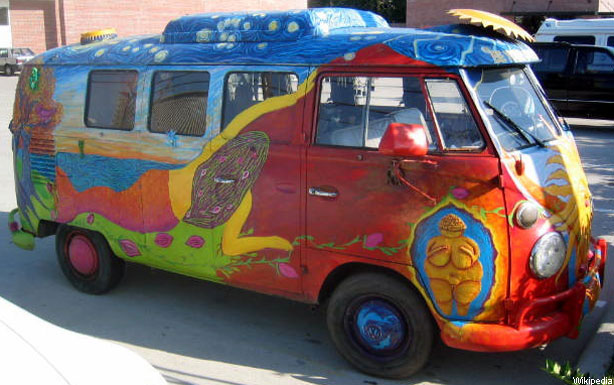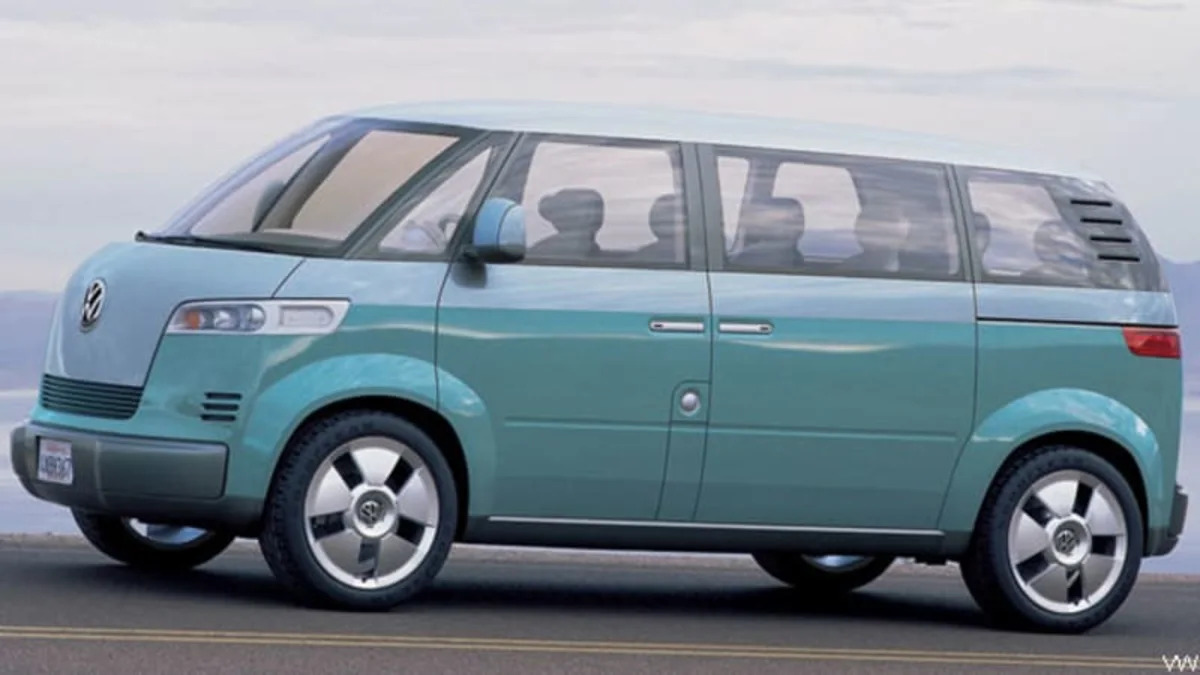It's hard to remember what time Volkswagen's press conference at the 2001 Detroit auto show actually started, but it should have been scheduled for 4:20. That was the year that VW teased the flower power generation with a new version of its iconic "Bus." But this one wasn't so much a hippie RV than it was a stylish alternative to the common minivan. VW was inspired by the runaway success of its New Beetle, which had launched in 1998 and become a hit. Baby Boomers had grown up, cut their hair, voted for Reagan and were now enjoying a self-indulgent lifestyle made possible by banking deregulation that allowed them to use their suburban homes as ATM machines. In turn, they flocked to the modern interpretation of the "Bug." Could the same retro trick ignite sales of a VW bus? That was the question.
The reality was that VW already had a van on sale in the U.S., although you would have hardly known it. Despite its direct lineage back to the original Microbus, Volkswagen's Eurovan was a slow seller in the U.S. at the time, so it seemed only logical that the German automaker would double down on its retro strategy.

If there was a good argument against reviving the Microbus, it was the concept itself. While it garnered plenty of positive publicity in the wake of the auto show, it's hard to see why. Other than the oversize VW logo on the nose, there was little to link it to the fondly remembered Bus. In fact, the Microbus concept looked more like a reimagining of the Previa, the bizarre, mid-engined, supercharged minivan that Toyota had been struggling to sell here through most of the '90s. At least the Microbus was a more traditional front-wheel-drive minivan, and when Volkswagen announced in 2002 that it would be headed for production, it was slated to share VW's commercial van platform.
Inside the Microbus, appointments were luxurious like no VW people mover that preceded it. If that was going to be its appeal, Volkswagen was certainly playing to its strength, as it had already begun to forge its reputation for first-rate interiors. The Microbus featured a whole host of features that seem perhaps a bit trite today but were still novel in 2001. Both sliding side doors were motorized to open and close automatically. A ceiling-mounted LCD wowed show-goers, as did a second display for the van's backup camera. The Microbus's Xenon headlights and 20-inch wheels wouldn't become standard fare in the industry for years. Neither would its swivel seats, which made an appearance seven years later when the fifth-generation Chrysler minivans debuted them in 2008.
Alas, when Volkswagen got closer to its promised 2005 launch of the Microbus, it got cold feet. Or rather, it became hot for one of those rebadged automotive deals that always makes car companies look foolish. In this case it was the aforementioned Chrysler minivan being tarted up with slightly revised interior and called the Routan, a deal brokered by former DaimlerChrysler honcho Wolfgang Bernhard after he joined Volkswagen.
Other than continuing VW's policy of giving its vehicles unpronounceable names, the Routan was an absolute failure. Even the marketing for the vehicle, which featured Brooke Shields and proclaimed the minivan "German-engineered" (which, though disingenuous, was actually true, as the vehicle had been developed by the altogether-too-German-for-its-own-good DaimlerChrysler), was insipid. Perhaps this criticism of the Routan is a bit harsh, but surely the VW Microbus deserved a better successor. We can only ask, what were they smoking in Wolfsburg?
The reality was that VW already had a van on sale in the U.S., although you would have hardly known it. Despite its direct lineage back to the original Microbus, Volkswagen's Eurovan was a slow seller in the U.S. at the time, so it seemed only logical that the German automaker would double down on its retro strategy.

If there was a good argument against reviving the Microbus, it was the concept itself. While it garnered plenty of positive publicity in the wake of the auto show, it's hard to see why. Other than the oversize VW logo on the nose, there was little to link it to the fondly remembered Bus. In fact, the Microbus concept looked more like a reimagining of the Previa, the bizarre, mid-engined, supercharged minivan that Toyota had been struggling to sell here through most of the '90s. At least the Microbus was a more traditional front-wheel-drive minivan, and when Volkswagen announced in 2002 that it would be headed for production, it was slated to share VW's commercial van platform.
Inside the Microbus, appointments were luxurious like no VW people mover that preceded it. If that was going to be its appeal, Volkswagen was certainly playing to its strength, as it had already begun to forge its reputation for first-rate interiors. The Microbus featured a whole host of features that seem perhaps a bit trite today but were still novel in 2001. Both sliding side doors were motorized to open and close automatically. A ceiling-mounted LCD wowed show-goers, as did a second display for the van's backup camera. The Microbus's Xenon headlights and 20-inch wheels wouldn't become standard fare in the industry for years. Neither would its swivel seats, which made an appearance seven years later when the fifth-generation Chrysler minivans debuted them in 2008.
Alas, when Volkswagen got closer to its promised 2005 launch of the Microbus, it got cold feet. Or rather, it became hot for one of those rebadged automotive deals that always makes car companies look foolish. In this case it was the aforementioned Chrysler minivan being tarted up with slightly revised interior and called the Routan, a deal brokered by former DaimlerChrysler honcho Wolfgang Bernhard after he joined Volkswagen.
Other than continuing VW's policy of giving its vehicles unpronounceable names, the Routan was an absolute failure. Even the marketing for the vehicle, which featured Brooke Shields and proclaimed the minivan "German-engineered" (which, though disingenuous, was actually true, as the vehicle had been developed by the altogether-too-German-for-its-own-good DaimlerChrysler), was insipid. Perhaps this criticism of the Routan is a bit harsh, but surely the VW Microbus deserved a better successor. We can only ask, what were they smoking in Wolfsburg?


Sign in to post
Please sign in to leave a comment.
Continue